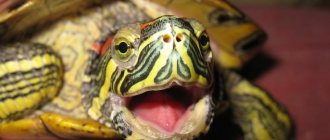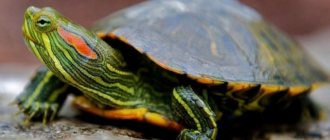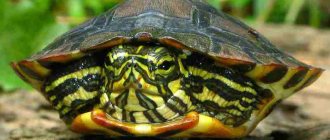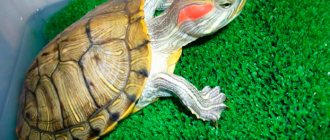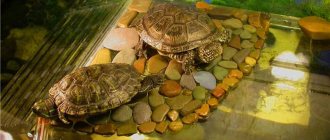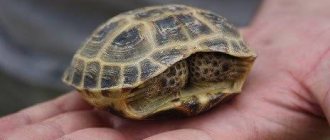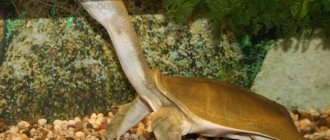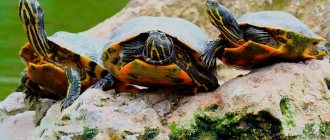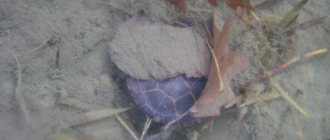The red-eared slider is the most common species of pet turtle.
This reptile has a medium size, interesting color and has a fairly high level of intelligence. In intelligence it is superior to many other species of its own kind. The red-eared one appeared in artificial terrariums many years ago; now such a pet can be purchased at any pet store. She is considered a long-liver: under favorable conditions, the pet can live thirty - forty (30 - 40) years. However, many owners of such a reptile do not know how often, what and in what quantities to feed their red-eared turtle . In our article we will try to answer this important question.
What do you feed red-eared turtles at home?
Despite the fact that red-eared turtles are unpretentious eaters and are omnivorous creatures, the basis of reptile nutrition should be food high in protein.
An approximate diet for a red-eared slider includes the following components:
- Meat and animal by-products.
- Various types of fresh fish and seafood, dried factory feed.
- Plant foods – greens, fruits and vegetables.
- Insects.
- Mushrooms.
In addition to this list of products, additional nutrition in the form of vitamins and minerals is necessary for the healthy development of the turtle. This is especially true at the stage of growing up of an individual, whose growing body needs microelements. If your pet regularly eats fresh meat, fish and vegetables, taking vitamins is not necessary. However, some owners, trying to save on keeping their pet, feed the turtle exclusively with semi-finished products, which have very dubious benefits. In this case, a course of vitamins is vital.
Turtle eats cabbage
It is important to remember that the diet of turtles largely depends on their age. Young individuals under one year of age take the necessary elements for the development of the body in products of animal origin. It is recommended to feed an adult turtle more varied, adding plant foods to the diet.
Meat
When purchasing an aquatic turtle, the owner of the reptile should be prepared to spend money on healthy food for the pet. The diet should include meat and offal as the main source of protein and vitamin A. Turtles like to eat the following types of meat:
- rabbit meat;
- lean poultry;
- beef.
Fatty pork and lamb are contraindicated for turtles. Meat is occasionally given raw, but more often the product must be boiled so that pathogenic bacteria do not enter the animal’s body. Regular consumption of raw meat can lead to the development of rickets.
In addition to small pieces of boiled beef or poultry, red-eared turtles happily eat offal such as liver and heart. Food is easily digested and has a beneficial effect on the health of the individual’s skin. In some cases, large turtles may eat a small mouse.
What fish to feed red-eared turtles
One of the most important components of a healthy turtle diet is sea and river fish. Any low-fat variety will do, the main thing is to process the fillet correctly. The food should be completely free of bones and offal. Experts advise pre-holding the fish in hot water to rid the product of harmful substances.
Red-eared turtles love to hunt for small fish. They happily eat guppies, crucian carp, swordtails and other inhabitants of home aquariums. A real delicacy for these reptiles is seafood, which does not require pre-processing and is served raw. A sea cocktail for a red-eared reptile may consist of the following ingredients:
- green shrimp;
- shellfish;
- squid pieces;
- octopus meat;
- snails and much more.
To ensure that your turtle regularly receives the required dose of calcium, try to pamper your pet more often with pieces of sea fish and other seafood. In their natural habitat, the diet of aquatic turtles consists of more than fifty percent fish, which must be taken into account when keeping the animal at home.
Red-eared turtle eats fish
Insects
During the hot summer season, the diet of the red-eared turtle at home is significantly enriched with various types of insects. Red-eared pets eat grasshoppers, small bugs, and smooth caterpillars with appetite. At any time of the year, you can buy mealworms, daphnia and corerta in stores.
The owner of a turtle who decides to treat his pet to caught cockroaches is acting very recklessly. The fact is that their body may contain poison, which the residents of the house used to try to get rid of unwanted insects. Once ingested by a turtle, the toxic substance is often fatal.
In order for the turtle to eat well and its diet to include a variety of foods, it is necessary to include insects in the diet. However, care must be taken to ensure that beetles, caterpillars and grasshoppers are not exposed to poisons. It’s better not to risk it and buy quality food at a pet store.
Animal feed
The red-eared slider is a predatory reptile, so its diet must include animal products. The owner of the shell can be fed the following types of meat and fish foods:
- boiled and raw lean meat (poultry, veal, lamb);
- sea and river fish processed with hot water;
- seafood (octopus, squid, mussels, etc.);
- various types of insects;
- small mice.
The consumption of protein and calcium, which are the main components of animal feed, is especially important for young animals. The condition of the animal’s skin, its bones and the overall health of the pet directly depends on what the red-eared turtle eats.
Plant food
In the second year of life, experienced turtle breeders gradually introduce most plant-based foods into the reptile's diet. These include:
- fruits (apples and pears, some varieties of citrus fruits, peaches and plums);
- vegetables (broccoli, tomatoes, cucumbers, legumes, carrots, beets, etc.);
- green plants (meadow grass, lettuce);
- occasionally mushrooms in small quantities (champignons, boletus mushrooms);
- aquarium algae and dried seaweed.
As the animal matures, plant components are added to its diet. Despite the fact that a variety of algae and grasses seem to be the safest food for a turtle, some representatives of aquatic and terrestrial flora can harm your pet. Red-eared reptiles eagerly eat algae growing in the aquarium. Most often, breeders place spirogyra sprouts, duckweed and pond algae in aquariums. But the juice of the poisonous elodea will poison the turtle, and the animal may die.
Turtle eats
Like any other food, vegetables, fruits and mushrooms need to be processed and cut into small pieces. Some inexperienced owners try to feed their red-eared pets berries with seeds or even orange peel. Even if an animal eats an inedible dish, it can lead to unpleasant consequences.
Artificial feed
Professional breeders of red-eared pets treat artificial food with a fair amount of skepticism. Everyone knows that natural food is much healthier than semi-finished products. In addition, most manufacturers, when creating ready-made food, do not take into account the characteristics of the turtle’s body, and minimally modify dry fish food, selling it under a different name. Of course, you shouldn’t feed a sea turtle such a dubious product.
Currently, a variety of foods for red-eared turtles are available on the shelves of pet stores, but only a few manufacturers create truly high-quality products with a balanced composition. Even high-quality food in the form of flakes, capsules or tablets should constitute a minimal part of the red-eared reptile's diet. The best way out of the situation is to make your own food from vegetables, fruits and fish, which will become healthy food for the red-eared turtle.
Vitamins and mineral supplements for turtles
Sometimes even feeding exclusively natural products does not guarantee that the red-eared turtle’s body will develop correctly. An important stage in the maturation of this reptile is the formation of bones and shell. To strengthen the skeleton, experts advise feeding turtles once a week with food containing vitamin supplements.
Bone meal is most often used as a source of calcium, necessary for the construction of skeletal and shell cells, a pinch of which is added to reptile food. Juveniles need a daily dose of calcium, while an adult turtle will only need one teaspoon of flour per week. If the owner of a water turtle does not have the opportunity to feed his pet with healthy flour, you can use ground eggshells of a raw egg for this purpose.
Caring for your turtle
The first thing you should pay attention to when purchasing a pet is its appearance and size. A turtle that is under 5 cm in size at the time of purchase will be very difficult to raise.
At this age, small individuals are susceptible to various infections and diseases. This is how natural selection takes place. Therefore, a turtle 5–7 cm in size will be the best choice when purchasing.
You should also carefully examine the color of the shell. The claws and tail must be intact. The skin looks healthy and the eyes shine. After the pet is in the aquarium, watch how it swims. A healthy turtle should swim smoothly, without leaning in different directions.
Healthy turtle
Features of treatment
After purchasing a pet and moving it into an aquarium, it may go through an adaptation period. Typically it will take 2 to 5 days. At this time, the animal becomes a little inhibited, or, conversely, very active. There is no need to panic and pick up the animal. Give him peace and time to adapt to new conditions. After a while, the turtle will get used to the new environment and become calmer.
When trying to pick up a turtle, do it very carefully and always with both hands. Not all representatives are willing to make contact. Some may flounder, hiss, and defecate in fear. The shell becomes slippery in water; keep this fact in mind when removing your pet from the aquarium.
After you hold the turtle in your hands, be sure to wash them with soap. Despite being kept clean, turtles are often carriers of salmonellosis. To avoid the spread of infection, you must always monitor the condition of the aquarium and the quality of the food.
Cleaning the shell
Since green algae in an aquarium is a source of infection, it is important to regularly clean not only the container, but also the turtle’s shell. They can't do it themselves
During the decomposition process, algae also fall under the surface of the shell, and as they decompose, they harm the shell.
You will get used to the fact that once every 3-5 days you need to take the turtle out of the water and wipe its shell with a clean cloth, a special soft napkin, or gently brush it with a toothbrush. During the process, you should try to remove all small particles of algae and other dirt.
Cleaning the shell with a toothbrushSome unscrupulous owners try to make the turtle's shell beautiful and lubricate it with various oils or creams to add shine. This is strictly prohibited, as it harms the skin and interferes with the healthy “breathing of the body” of the pet.
How often to feed your red-eared turtle
The frequency of feeding a sea turtle depends on several factors, the main of which are the animal and its individual characteristics. Thus, feeding adult red-eared turtles will take a minimal amount of time from their owners. The older the reptile gets, the less often it is fed. For some individuals, one serving per week is enough. However, there are some nuances.
If your pet's diet preferably consists of plant-based foods, the frequency of feeding increases. Meat and fish need more time to digest, and animal food saturates the turtle’s body for a long time. However, you should arrange the flora of the aquarium so that your pet can snack on algae if desired.
How many times a day should you feed your red-eared slider?
A turtle of any age only needs one portion of food per day. Very young individuals are fed daily, eventually increasing the period of abstinence to a week.
Turtle eats meat
Nutrition
Vulture turtles feed on crustaceans and mollusks, worms, and attack snakes and smaller turtles, mammals and birds. They do not disdain plant foods.
But still, the main part of the snapping turtle’s diet is fish. If a turtle comes across a large fish, it will tear it into pieces before eating it.
The snapping turtle hunts in an interesting way using Peckham mimicry. This type of mimicry is not that rare in the animal kingdom. Its essence comes down to the fact that the hunter lures prey by imitating its favorite food. The snapping turtle uses its worm-like tongue, or more precisely, its appendage at the tip, as bait. She lies down on the bottom, most often in a thicket of algae, opens her mouth and begins to move the tip of her tongue. At the same time, the turtle lies motionless so as not to scare away the prey. When a fish or other prey, attracted by the movements of the tongue, swims close to it, the turtle instantly closes its mouth. This worm-like bait attracts not only fish, but also amphibians and invertebrates. Sometimes a snapping turtle can catch a snake or a smaller turtle.
What to feed baby red-eared turtles
What a little turtle eats determines its future health. The diet of young animals must include seafood. It is useful for armored babies to hunt aquarium fish. Turtles can be given clams and pieces of shrimp, but the food is always served raw. You cannot feed small red-eared turtles with products of plant origin - such food will not bring the desired benefits.
The first year of life of red-eared reptiles is very important for the formation of the skeleton and strong shell. For the healthy development of the body, babies need calcium and vitamin A, which is aimed at renewing skin cells and creating keratinized tissue. The turtles are fed daily, adding bone meal to the portions. In addition to fresh fish, you can purchase combined dry food for young animals at a pet store, after consulting with the seller.
Reproduction of representatives of the species
Representatives of this species mate from the age of 4 (males) and from 5 years (females). In order for animals to produce offspring in the future, you need to prepare an aquarium in advance. The water level should be at least 10 cm. This is necessary so that the female does not remain without water for a long time during the mating period. Then you need to prepare a dry place where the female will lay eggs in the future.
For proper mating, there should only be one boy and one girl in the aquarium. Otherwise, male turtles will fight, and they do it very aggressively - they bite off each other’s tails and paws. After the female lays eggs, they must be transferred to an incubator - a container with sand. The layout is similar to a chicken incubator. The ideal temperature for egg maturation is 25–27 C. On average, it takes about 5 months for a turtle to be born.
Incubator container
After hatching, the babies should not be allowed into the aquarium with adults, since the latter do not have developed maternal and paternal instincts, and they can attack turtles.
If turtles are properly cared for and feeding recommendations are followed, they will delight their owners for decades.
Dreaming of becoming the owner of a reptile, pet store visitors often opt for the red-eared turtle
This animal does not require careful care, but feeding the turtle must be approached with special attention. The harmless reptile is a real predator, so you need to feed it not only plant food, but also protein food, which will make the red-eared turtle healthy
What should you not feed your red-eared turtle?
Despite the fact that this armored reptile is considered an omnivore, there is a certain list of foods that are strictly contraindicated for these animals. The list of foods harmful to turtles includes the following components:
- poisonous land plants and algae (Elodia, Ambulia, Legendandra);
- plant and animal products containing large amounts of oscalates, phosphorus, purines (tomatoes, cabbage, raw liver, fatty meat, etc.);
- poisonous and poisonous insects;
- locusts and grasshoppers with serrated stalks;
- fatty meat and fish;
- bread, potatoes, etc.
Many of the above foods contain substances that can lead to the development of diseases such as gout, goiter and iodine deficiency in the turtle. The seemingly beneficial phosphorus interferes with the absorption of calcium, which also applies to oscalates.
Feeding time
Turtles are active during the day and sleep at night. A temperature difference is created in the terrarium - it is warmer during the day than at night: an incandescent lamp and a thermal mat are on. In the morning, warming up under the heat emitter, the cold-blooded animal increases its body temperature. When it reaches 30⁰C, the body is ready to digest food.
In a warmed reptile, digestion and absorption of nutrients are more intense. Therefore, the feeder is not placed in the terrarium as soon as the lamps are turned on and the animal wakes up. And after some time. If fed in the evening, then three to four hours before bedtime, so that digestion takes place in the warmth at an optimal pace.
How to properly feed a red-eared turtle
Even knowing the exact list of what red-eared sliders eat or don’t eat, you can make a number of dangerous mistakes. The most common disease of armored reptiles is common overeating. The owner of the animal needs to develop a strict feeding schedule for the pet in order not to succumb to the provocations of the cunning little face that is just begging. However, if it is obvious that the turtle is hungry, it must be fed.
The turtle feeder should not be overcrowded; too much food can also lead to overeating. Having fed the pet to its fullest, after a while the owner notices that the animal has become lethargic and passive. In this case, you should contact your veterinarian. If you still think that the reptile does not have enough food, it is better to give preference to algae and other products of plant origin. The health and longevity of a turtle directly depends on how much food the pet regularly consumes.
It is important to know how to feed a turtle in such a way that its body receives all the necessary substances. In addition to a varied, complete diet, owners of armored pets should not forget about vitamins. To make the skeleton and shell of the sea creature stronger, it is worth feeding your pet with bone meal once a week.
If, however, the red-eared turtle stops eating, you should look for the cause and begin treatment.
Artificial feed
Pet stores generously offer a wide variety of food for turtles , but such mixtures do not cover the reptile’s need for proteins and microelements.
Homemade food
If store-bought food is not suitable for your turtle, you can prepare the food yourself.
Take:
- 50 g cabbage;
- 70 g carrots;
- 150 g lean fish;
- 50 g apples;
- 100 g squid meat.
The products are passed through a meat grinder or crushed with a blender . Add 2 eggs, gelatin (1 tablespoon per 150 ml of water) and 150 ml of milk to the mixture. Mix everything thoroughly and store in the refrigerator for no more than a week.
This amount of food is enough for about 10 servings for one small turtle. Before serving, food is cut into portions.
Is it possible to give turtles dog/cat food?
Although turtles eat commercial cat and dog food with great pleasure, such a diet does not benefit them.
Such mixtures do not contain the microelements necessary for reptiles, and abuse of such a diet will lead to serious health problems for the turtle .
Health, disease and prevention
Almost 90% of all diseases of the red-eared turtle occur as a result of improper maintenance or failure to comply with care requirements. The presence of dirty water in an aquarium quickly causes a sharp deterioration in the turtle's health.
A sick aquatic animal must be kept at a temperature increased by about 2-3°C, which helps to improve the functioning of the immune system. It is also necessary to monitor the turtle's drinking regime, since dehydration can cause the death of a freshwater turtle due to the rapid development of kidney failure.
The animal's ill health is evidenced by the characteristics of the movements of a swimming red-eared turtle. A sick pet most often moves in a position “on its side” or simply sinks to the bottom. If an infectious nature of the disease is suspected, all animal care items should be thoroughly treated with an antiseptic that is safe for pets. As a rule, the first symptoms of a bacterial infection are represented by the appearance of edema and necrotic changes. In this case, a treatment regimen with antibiotics is prescribed, and the water in the aquarium is completely replaced.
When injured, a red-eared turtle, under the influence of an infection that has entered the body, develops blood poisoning, accompanied by redness of the paws and very pronounced lethargy. This pathology is classified as difficult to treat and therefore requires urgent and qualified assistance from specialists. Untimely treatment often causes the death of a pet as a result of dysfunction of internal organs.
Preventive measures are presented:
- daily inspection of the turtle;
- regular cleaning of the aqua terrarium;
- regular change of water in the aqua terrarium;
- proper organization of nutrition;
- preventing hypothermia;
- regular checking of the performance of illuminators, as well as heating and filtering devices;
- observing the rules of personal hygiene when caring for a pet;
- systematically cleaning the turtle shell from algae;
- mandatory quarantine for sick or newly acquired turtles;
- limiting the contact of a sick turtle with any other pets and family members;
- control of the animal’s movement outside the aqua-terrarium;
- periodic ultraviolet irradiation and sunbathing;
- regular examination by a veterinarian.
If the diet is incorrectly prepared, the freshwater animal develops calcium deficiency, which manifests itself in the form of curvature or severe softening of the shell. Too much calcium deficiency greatly increases your red-eared turtle's risk of death. In order to quickly normalize the general condition of the reptile, the veterinarian prescribes calcium supplements in injections.
Plant food
In order to properly maintain reptiles, it is worth including in the menu not only animal food, but also plant food mixtures.
Plants can be fed to young and adult individuals, and with age the amount of this food should increase. When keeping a turtle in an aquarium, the menu must include the following herbal components:
Important! Is it possible to give reptiles food from the human table (bread, cheese, cottage cheese, sausage, cereals and others)? In no case, it can negatively affect the functioning of the digestive system. Also avoid feeding pet food, citrus peels, and berries with seeds.
If there are several animals
In one aquarium you can only keep individuals of similar size. His safety depends on the size of the neighbor. If young animals are placed with an adult reptile, it can easily inflict serious injuries on it, deliberately freeing its territory. When several pets live in an aquarium, fights can begin between them due to the formation of a hierarchy. If there is not enough space, such skirmishes often lead to the fact that weaker individuals are left without paws and tails, and sometimes die.
In order to reduce the aggressiveness of your pets, you need to feed them individually and outside the aquarium. This way the animals will not build a hierarchy and organize massacres. Shelters will also help. The behavior of reptiles is the same as in the wild, which is why all the difficulties arise due to the fact that they do not have sufficient areas. To eliminate this unpleasant phenomenon, you should still keep your pets alone. This will make it easier for both them and the owner. The absence of a neighbor does not affect the animal's condition, and it does not feel lonely.
Watch a video of interesting facts about turtles.
Aquaterrarium
This is the correct name for the place where the red-eared turtle should live. Aqua- (water) and terra- (earth) - the turtle should be able to swim and crawl onto the shore (island) as needed. The volume of water for an average-sized turtle needs at least 60 liters, the container is mainly of a horizontal type. The older the turtle, the more time it spends on land, which means it makes sense to increase the island as the pet grows.
Aquaterrarium for the red-eared turtle.
Another important point is maintaining water quality. Little Reds are assholes! They eat sloppily, poop and pee a lot, so maintaining water quality is a top priority. The following things will help you achieve cleanliness in your aquarium.
- Filter. Optimally - internal, with a good flow reserve (3-4 volumes per hour) and a large sponge. There is no reason to install an external filter: anyway, it will not be possible to completely close the nitrogen cycle (as in an aquarium with fish), and the cost of good external filters is very high.
- Feeding outside the aquarium. Teach your animal from a very early age to receive food in a separate container. It is better to take water into the container directly from the aquarium - this way you will maintain the usual chemical and physical parameters of the water. After feeding, the water should be poured out of the container and fresh water should be added to the aquarium. This way, scraps are prevented from getting into the living space and at the same time a kind of “ventilation” is carried out by replacing part of the water.
- It is useful to change the water from time to time - about half the volume weekly. Fresh water should be at the usual temperature. In a large aquarium, it is convenient to do the change using a large hose - drain the required amount of water into a bucket or directly into the toilet and pour it back through the same hose directly from the tap, if you have coarse water filters in your house. If there are no filters, then cold water is mixed with boiling water in a separate bucket until the desired temperature is reached. Water conditioners should be used in spring and autumn, when melted snow or heavy precipitation from city streets enters the central water supply. It is very inexpensive to use pond conditioners - they do not differ in composition from aquarium conditioners, but are more concentrated. The air conditioner is calculated based on the volume of water being replaced, and not on the entire volume of the aquarium.
- It is permissible for turtles to change the water completely. If you missed changes and/or the water has an unpleasant odor, you can completely change the water by wiping the decorations and walls of the aquarium with a sponge. When completely changing the water, it is also advisable to use an air conditioner. There is no need to constantly wash the aquarium - the water should normally have a pleasant “living” smell, like a lake or a slow-moving river.
About the reptile
The red-eared or yellow-bellied turtle belongs to the class Reptiles, order Turtles, family American freshwater turtles. The red-eared turtle was first mentioned and described in the book “Chronicle of Peru” by Pedro Sierra de Leon, written in 1553. There are 15 subspecies of red-eared turtles, but at home one of them is mainly kept - the red-eared slider, which is also called the Florida slider. Red-eared turtles grow up to 30 cm. The size of the male is much smaller than the females, and this tells you how to distinguish them in adulthood.
The little turtle has a rich green color of its shell, which in nature makes it easier for it to hide from predators. As they grow older, the color changes to dark olive or brownish-yellow. The description of the red-eared turtle explains its name: next to the eyes of the reptile there is an elongated, medium-sized spot of a rich red color. Reptiles feed on both animal and plant foods. The animal eats small fish and amphibians, mollusks, invertebrates, and aquatic plants.
The reptile has a well-developed vocal apparatus, which is why it can make loud hissing and snorting sounds, and also squeak abruptly. It is known about the red-eared turtle that its eyesight and sense of smell are good. Thanks to this, an adult red-eared turtle can have good contact with the owner, recognizing him.
Red-eared cats have weak hearing. However, they react to fairly strong sounds and immediately run into the water from the noise. In nature, animals sense the approach of a predator through their senses of smell and vision. The red-eared turtle can detect the approach of an enemy at a distance of 40 m. In its natural habitat, this water turtle has the peculiarity of plunging into hibernation, burrowing into the ground. Life expectancy under favorable conditions is up to 40 years.
